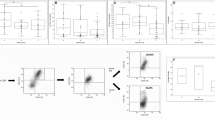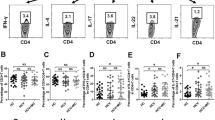Abstract
The aim was to investigate circulating levels of interelukin (IL)-1β, IL-6 and tumor necrosis factor (TNF)-α, chemokine (C–X–C motif) ligand (CXCL)10, CXCL11 and chemokine (C–C motif) ligand (CCL)2 in “mixed cryoglobulinemia and hepatitis C” (MC + HCV). Serum levels of CXCL11, IL-1β, TNF-α, IL-6, and CCL2 were evaluated in 52 MC + HCV vs 52 sex- and age-matched controls to correlate them to the clinical features of mixed cryoglobulinemia. CXCL11 was significantly higher in MC + HCV than in controls (264 ± 279 vs 70 ± 16 pg/mL, respectively; P = 0.0002; univariate analysis of variance (ANOVA)), in particular in 23 MC + HCV with active vasculitis vs those without (293 ± 221 vs 168 ± 57 pg/mL, respectively; P < 0.001; ANOVA). Significantly high IL-1β, IL-6, TNF-α, CXCL10, and CCL2 in MC + HCV vs healthy controls were confirmed. In a multiple linear regression model (CXCL11 or CCL2, vs age, alanine aminotransferase, IL-1β, IL-6, TNF-α, and CXCL10), CXCL11 was significantly associated with high CXCL10 (P < 0.001), while CCL2 with high IL-6 (P < 0.001). This study demonstrates in MC + HCV high serum levels of (a) T-helper 1 chemokines, CXCL11 and CXCL10 (related to each other) and (b) proinflammatory cytokines IL-6 and CCL2 (related to each other).


Similar content being viewed by others
References
Ferri C, Antonelli A, Mascia MT, Sebastiani M, Fallahi P, Ferrari D, Pileri SA, Zignego AL (2007) HCV-related autoimmune and neoplastic disorders: the HCV syndrome. Dig Liver Dis 39(Suppl 1):S13–S21
Antonelli A, Ferri C, Galeazzi M, Giannitti C, Manno D, Mieli-Vergani G, Menegatti E, Olivieri I, Puoti M, Palazzi C, Roccatello D, Vergani D, Sarzi-Puttini P, Atzeni F (2008) HCV infection: pathogenesis, clinical manifestations and therapy. Clin Exp Rheumatol 26(1 Suppl 48):S39–S47
Antonelli A, Ferri C, Ferrari SM, Colaci M, Fallahi P (2008) Immunopathogenesis of HCV-related endocrine manifestations in chronic hepatitis and mixed cryoglobulinemia. Autoimmun Rev 8:18–23. doi:10.1016/j.autrev.2008.07.017
Antonelli A, Ferri C, Ferrari SM, Colaci M, Sansonno D, Fallahi P (2009) Endocrine manifestations of hepatitis C virus infection. Nat Clin Pract Endocrinol Metab 5:26–34. doi:10.1038/ncpendmet1027
Antonelli A, Ferri C, Ferrari SM, Ghiri E, Goglia F, Pampana A, Bruschi F, Fallahi P (2009) Serum levels of proinflammatory cytokines interleukin-1beta, interleukin-6, and tumor necrosis factor alpha in mixed cryoglobulinemia. Arthritis Rheum 60:3841–3847. doi:10.1002/art.25003
Antonelli A, Ferri C, Fallahi P, Ferrari SM, Sebastiani M, Ferrari D, Giunti M, Frascerra S, Tolari S, Franzoni F, Galetta F, Marchi S, Ferrannini E (2008) High values of CXCL10 serum levels in mixed cryoglobulinemia associated with hepatitis C infection. Am J Gastroenterol 103:2488–2494. doi:10.1111/j.1572-0241.2008.02040.x
Antonelli A, Ferri C, Fallahi P, Ferrari SM, Frascerra S, Carpi A, Nicolini A, Ferrannini E (2008) Alpha-chemokine CXCL10 and beta-chemokine CCL2 serum levels in patients with hepatitis C-associated cryoglobulinemia in the presence or absence of autoimmune thyroiditis. Metabolism 57:1270–1277. doi:10.1016/j.metabol.2008.04
Antonelli A, Ferri C, Fallahi P, Ferrari SM, Frascerra S, Franzoni F, Galetta F, Zignego AL, Ferrannini E (2009) CXCL10 and CCL2 serum levels in patients with mixed cryoglobulinaemia and hepatitis C. Dig Liver Dis 41:42–48. doi:10.1016/j.dld.2008.04.009
Sansonno D, Tucci FA, Troiani L, Lauletta G, Montrone M, Conteduca V, Sansonno L, Dammacco F (2008) Increased serum levels of the chemokine CXCL13 and up-regulation of its gene expression are distinctive features of HCV-related cryoglobulinemia and correlate with active cutaneous vasculitis. Blood 112:1620–1627. doi:10.1182/blood-2008-02-137455
Cole KE, Strick CA, Paradis TJ, Ogborne KT, Loetscher M, Gladue RP, Lin W, Boyd JG, Moser B, Wood DE, Sahagan BG, Neote K (1998) Interferon-inducible T cell alpha chemoattractant (I-TAC): a novel non-ELR CXC chemokine with potent activity on activated T cells through selective high affinity binding to CXCR3. J Exp Med 187:2009–2021. doi:10.1084/jem.187.12.2009
Erdel M, Laich A, Utermann G, Werner ER, Werner-Felmayer G (1998) The human gene encoding SCYB9B, a putative novel CXC chemokine, maps to human chromosome 4q21 like the closely related genes for MIG (SCYB9) and INP10 (SCYB10). Cytogenet Cell Genet 81:271–272. doi:10.1159/000015043
O’Donovan N, Galvin M, Morgan JG (1999) Physical mapping of the CXC chemokine locus on human chromosome 4. Cytogenet Cell Genet 84:39–42. doi:10.1159/000015209
Cox MA, Jenh CH, Gonsiorek W, Fine J, Narula SK, Zavodny PJ, Hipkin RW (2001) Human interferon-inducible 10-kDa protein and human interferon-inducible T cell alpha chemoattractant are allotopic ligands for human CXCR3: differential binding to receptor states. Mol Pharmacol 59:707–715
Romagnani P, Annunziato F, Lasagni L, Lazzeri E, Beltrame C, Francalanci M, Uguccioni M, Galli G, Cosmi L, Maurenzig L, Baggiolini M, Maggi E, Romagnani S, Serio M (2001) Cell cycle-dependent expression of CXC chemokine receptor 3 by endothelial cells mediates angiostatic activity. J Clin Invest 107:53–63. doi:10.1172/JCI9775
Bonecchi R, Bianchi G, Bordignon PP, D’Ambrosio D, Lang R, Borsatti A, Sozzani S, Allavena P, Gray PA, Mantovani A, Sinigaglia F (1998) Differential expression of chemokine receptors and chemotactic responsiveness of type 1 T helper cells (Th1s) and Th2s. J Exp Med 187:129–134. doi:10.1084/jem.187.1.129
Antonelli A, Ferri C, Fallahi P, Ferrari SM, Frascerra S, Sebastiani M, Franzoni F, Galetta F, Ferrannini E (2008) High values of CXCL10 serum levels in patients with hepatitis C associated mixed cryoglobulinemia in presence or absence of autoimmune thyroiditis. Cytokine 42:137–143. doi:10.1016/j.cyto.2008.01.002
Ishak K, Baptista A, Bianchi L, Callea F, De Grootes J, Gudat F, Denk H, Desmet V, Korb G, MacSween RNM, Phillips MJ, Portmannl BG, Paulsen H, Scheuer PJ, Schmid M, Thaler H (1995) Histological grading and staging of chronic hepatitis. J Hepatol 22:696–699. doi:10.1016/0168-8278(95)80226-6
Antonelli A, Ferri C, Pampana A, Fallahi P, Nesti C, Pasquini M, Marchi S, Ferrannini E (2004) Thyroid disorders in chronic hepatitis C. Am J Med 117:10–13. doi:10.1016/j.amjmed.2004.01.023
Antonelli A, Ferri C, Ferrari SM, Ghiri E, Marchi S, Sebastiani M, Fallahi P (2010) Serum concentrations of interleukin 1beta, CXCL10, and interferon-gamma in mixed cryoglobulinemia associated with hepatitis C infection. J Rheumatol 37:91–97. doi:10.3899/jrheum.090246
Helbig KJ, Ruszkiewicz A, Semendric L, Harley HA, McColl SR, Beard MR (2004) Expression of the CXCR3 ligand I-TAC by hepatocytes in chronic hepatitis C and its correlation with hepatic inflammation. Hepatology 39:1220–1229. doi:10.1002/hep.20167
Bièche I, Asselah T, Laurendeau I, Vidaud D, Degot C, Paradis V, Bedossa P, Valla DC, Marcellin P, Vidaud M (2005) Molecular profiling of early stage liver fibrosis in patients with chronic hepatitis C virus infection. Virology 332:130–144. doi:10.1016/j/virol.2004.11.009
Zeremski M, Petrovic LM, Chiriboga L, Brown QB, Yee HT, Kinkhabwala M, Jacobson IM, Dimova R, Markatou M, Talal AH (2008) Intrahepatic levels of CXCR3-associated chemokines correlate with liver inflammation and fibrosis in chronic hepatitis C. Hepatology 48:1440–1450. doi:10.1002/hep.22500
Butera D, Marukian S, Iwamaye AE, Hembrador E, Chambers TJ, Di Bisceglie AM, Charles ED, Talal AH, Jacobson IM, Rice CM, Dustin LB (2005) Plasma chemokine levels correlate with the outcome of antiviral therapy in patients with hepatitis C. Blood 106:1175–1182. doi:10.1182/blood-2005-01-0126
Pockros PJ, Jeffers L, Afdhal N, Goodman ZD, Nelson D, Gish RG, Reddy KR, Reindollar R, Rodriguez-Torres M, Sullivan S, Blatt LM, Faris-Young S (2007) Final results of a double-blind, placebo-controlled trial of the antifibrotic efficacy of interferon-gamma1b in chronic hepatitis C patients with advanced fibrosis or cirrhosis. Hepatology 45:569–578. doi:10.1002/hep.21561
Zeremski M, Dimova R, Brown Q, Jacobson IM, Markatou M, Talal AH (2009) Peripheral CXCR3-associated chemokines as biomarkers of fibrosis in chronic hepatitis C virus infection. J Infect Dis 200:1774–1780. doi:10.1086/646614
Helbig KJ, Ruszkiewicz A, Lanford RE, Berzsenyi MD, Harley HA, McColl SR, Beard MR (2009) Differential expression of the CXCR3 ligands in chronic hepatitis C virus (HCV) infection and their modulation by HCV in vitro. J Virol 83:836–846. doi:10.1128/JVI.01388-08
Antonelli A, Ferri C, Ferrari SM, Ruffilli I, Colaci M, Frascerra S, Miccoli M, Franzoni F, Galetta F, Fallahi P (2011) High serum levels of CXCL11 in mixed cryoglobulinemia are associated with increased circulating levels of interferon-{gamma}. J Rheumatol 38:1947–1952. doi:10.3899/jrheum.110133
Panzer U, Steinmetz OM, Reinking RR, Meyer TN, Fehr S, Schneider A, Zahner G, Wolf G, Helmchen U, Schaerli P, Stahl RA, Thaiss F (2006) Compartment-specific expression and function of the chemokine IP-10/CXCL10 in a model of renal endothelial microvascular injury. J Am Soc Nephrol 17:454–464. doi:10.1681/ASN.2005040364
Takeuchi M, Oh-I K, Suzuki J, Hattori T, Takeuchi A, Okunuki Y, Usui Y, Usui M (2006) Elevated serum levels of CXCL9/monokine induced by interferon-gamma and CXCL10/interferon-gamma-inducible protein-10 in ocular sarcoidosis. Invest Ophthalmol Vis Sci 47:1063–1068. doi:10.1167/iovs.05-0966
Antonelli A, Rotondi M, Fallahi P, Grosso M, Boni G, Ferrari SM, Romagnani P, Serio M, Mariani G, Ferrannini E (2007) Iodine-131 given for therapeutic purposes modulates differently interferon-{gamma}-inducible {alpha}-chemokine CXCL10 serum levels in patients with active Graves’ disease or toxic nodular goiter. J Clin Endocrinol Metab 92:1485–1490. doi:10.1210/jc.2006-1571
Antonelli A, Rotondi M, Fallahi P, Romagnani P, Ferrari SM, Barani L, Ferrannini E, Serio M (2006) Increase of interferon-gamma-inducible CXC chemokine CXCL10 serum levels in patients with active Graves’ disease, and modulation by methimazole therapy. Clin Endocrinol (Oxf) 64:189–195. doi:10.1111/j.1365-2265.2006.02447.x
Antonelli A, Fallahi P, Rotondi M, Ferrari SM, Serio M, Miccoli P (2006) Serum levels of the interferon-gamma-inducible alpha chemokine CXCL10 in patients with active Graves’ disease, and modulation by methimazole therapy and thyroidectomy. Br J Surg 93:1226–1231. doi:10.1002/bjs.5401
Franciotta D, Martino G, Zardini E, Furlan R, Bergamaschi R, Andreoni L, Cosi V (2001) Serum and CSF levels of MCP-1 and IP-10 in multiple sclerosis patients with acute and stable disease and undergoing immunomodulatory therapies. J Neuroimmunol 115:192–198. doi:10.1016/S0165-5728(01)00261-2
Gangur V, Simons FE, Hayglass KT (1998) Human IP-10 selectively promotes dominance of polyclonally activated and environmental antigen-driven IFN-gamma over IL-4 responses. FASEB J 12:705–713
Antonelli A, Fallahi P, Rotondi M, Ferrari SM, Romagnani P, Grosso M, Ferrannini E, Serio M (2006) Increased serum CXCL10 in Graves’ disease or autoimmune thyroiditis is not associated with hyper- or hypothyroidism per se, but is specifically sustained by the autoimmune, inflammatory process. Eur J Endocrinol 154:651–658. doi:10.1530/eje.1.02137
Hosokawa Y, Hosokawa I, Ozaki K, Nakae H, Matsuo T (2009) Cytokines differentially regulate CXCL10 production by interferon-gamma-stimulated or tumor necrosis factor-alpha-stimulated human gingival fibroblasts. J Periodontal Res 44:225–231. doi:10.1111/j.1600-0765.2008.01124.x
Okuno T, Andoh A, Bamba S, Araki Y, Fujiyama Y, Fujiyama M, Bamba T (2002) Interleukin-1beta and tumor necrosis factor-alpha induce chemokine and matrix metalloproteinase gene expression in human colonic subepithelial myofibroblasts. Scand J Gastroenterol 37:317–324. doi:10.1080/003655202317284228
Antonelli A, Ferri C, Ferrari SM, De Marco S, Di Domenicantonio A, Centanni M, Pupilli C, Villa E, Menichetti F, Fallahi P (2010) Interleukin-1β, C-x-C motif ligand 10, and interferon-gamma serum levels in mixed cryoglobulinemia with or without autoimmune thyroiditis. J Interferon Cytokine Res 30:835–842. doi:10.1089/jir.2010.0024
Hwang CJ, Afifiyan N, Sand D, Naik V, Said J, Pollock SJ, Chen B, Phipps RP, Goldberg RA, Smith TJ, Douglas RS (2009) Orbital fibroblasts from patients with thyroid-associated ophthalmopathy overexpress CD40: CD154 hyperinduces IL-6, IL-8, and MCP-1. Invest Ophthalmol Vis Sci 50:2262–2268. doi:10.1167/iovs.08-2328
Yu N, Zhang S, Zuo F, Kang K, Guan M, Xiang L (2009) Cultured human melanocytes express functional toll-like receptors 2-4, 7 and 9. J Dermatol Sci 56:113–120. doi:10.1016/j.jdermsci.2009.08.003
Wong CK, Cao J, Yin YB, Lam CW (2010) Interleukin-17A activation on bronchial epithelium and basophils: a novel inflammatory mechanism. Eur Respir J 35:883–893. doi:10.1183/09031936.00088309
Author information
Authors and Affiliations
Corresponding author
Rights and permissions
About this article
Cite this article
Antonelli, A., Fallahi, P., Ferrari, S.M. et al. Parallel increase of circulating CXCL11 and CXCL10 in mixed cryoglobulinemia, while the proinflammatory cytokine IL-6 is associated with high serum Th2 chemokine CCL2. Clin Rheumatol 32, 1147–1154 (2013). https://doi.org/10.1007/s10067-013-2246-y
Received:
Revised:
Accepted:
Published:
Issue Date:
DOI: https://doi.org/10.1007/s10067-013-2246-y




